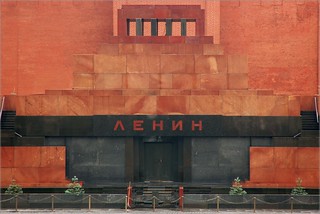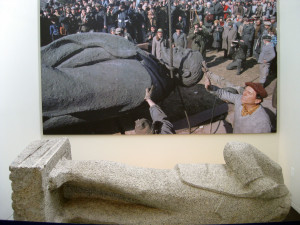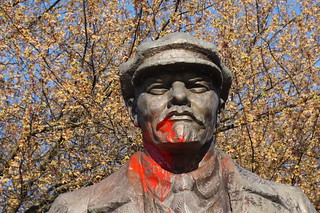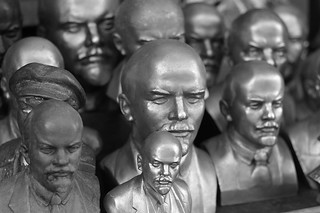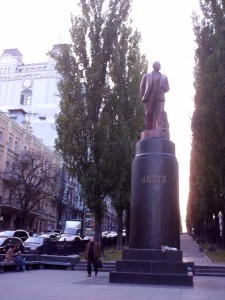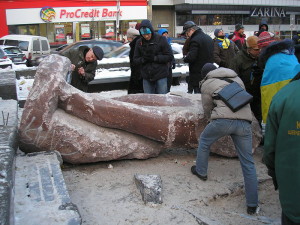-
Leninopad
See the Calvert Journal's "Looking for Lenin" for a fascinating series of photos by Neils Ackermann documenting dismantled Lenin statues across Ukraine.
-
Lenin Lives . . .
By Maryna Polataiko for postcommunistmonuments.ca
April 24, 2015 marks the 145th anniversary of the birth of Vladimir Lenin, founder of the Soviet Union. After Lenin’s death, his body was preserved and put on display. It is open to the public to this day. In preparation for the special occasion, the Lenin Mausoleum located in Moscow’s Red Square was shut down. The hundred and forty-five year-old communist was due for a touch-up, having sustained ninety years of postmortem embalming procedures.
His body’s journey spans from scientists’ Vladimir Vorobiev and Boris Zbarsky’s embalming methods of 1924, to a home care cholesterol test patented in 2002 that is now marketed in Canada. Want to know how much of the body is still the original Lenin? Read about the evolution of the body’s conservation—and its surrounding history—in Scientific American, as well as in University of California, Berkeley anthropologist Alexei Yurchak’s historical analysis in “Bodies of Lenin: The Hidden Science of Communist Sovereignty.”
[SOURCES:]
http://www.scientificamerican.com/article/lenin-s-body-improves-with-age1/
Jeremy Hsu. “Lenin’s Body Improves with Age.” Scientific American, April 22, 2015. Accessed April 25, 2015. http://www.scientificamerican.com/article/lenin-s-body-improves-with-age1/.
https://www.academia.edu/10400116/Bodies_of_Lenin_The_Hidden_Science_of_Communist_Sovereignty
Alexei Yurchak. “Bodies of Lenin: “The Hidden Science of Communist Sovereignty.” Representations 129 (2015): 116-157.
-
Poland's "Fountain of the Future"
- May 28, 2015 - 11:42 pm
- Lenin, New monument, Poland
- Comments Off on Poland's "Fountain of the Future"
By Maryna Polataiko for postcommunistmonuments.ca
Right now, many post-Soviet states are in the midst of a sculptural demolition derby. Numerous countries are trying to wipe communism from their public spaces by removing monuments of a bygone era. And while Poland is certainly participating in this trend—think the ‘Four Sleepers’ debacle in Warsaw—artists near Krakow have put their own spin on distancing themselves from Russia.
As part of the Grolsch ArtBoom Festival in Krakow, artists Małgorzata Szydłowska and Bartosz Szydłowsk produced a little, bright yellow Lenin. Standing where a Soviet-era Lenin once was (and was removed in 1989), the miniature’s fountain water doubles as a urine stream.
While the ‘Fountain of the Future’ is meant to be temporary—stimulating discussion on what should really be taking its place—a permanent residence for the peeing figure would not be so bad either.
[SOURCES:]
http://time.com/2867197/polish-city-erects-statue-of-peeing-lenin/
Denver Nicks. “Polish City Erects Statue of Peeing Lenin.” Time, June 12, 2014. Accessed June 22, 2015. http://time.com/2867197/polish-city-erects-statue-of-peeing-lenin/.
http://www.artslant.com/la/articles/show/39841
Max Nesterak. “Krakow Erects A Bright Yellow Statue of Lenin Peeing.” ArtSlant Los Angeles, June 13, 2014. Accessed June 22, 2015. http://www.artslant.com/la/articles/show/39841.
http://www.artboomfestival.pl/en/4/2/10361
“Big Boom in Nova Huta.” Grolsch Artboom Festival in Krakow, June 9, 2014. Accessed June 22, 2015. http://www.artboomfestival.pl/en/4/2/10361.
-
Hello Lenin!
By Maryna Polataiko for postcommunistmonuments.ca
In 1991, the city of Berlin demolished a 62-foot-high monument of Lenin in an attempt to leave its East/West divisions behind. Smashed to pieces, remnants of the statue were buried—with the head hidden in a sandpit on the outskirts of the city. Twenty-four years later, organizers of a museum exhibition are scheduling a showcase of around 100 historical monuments from Berlin. The 3.5 ton head would undoubtedly be a crowd-pulling highlight, laying bare the city’s communist past.
The exhibition is meant to provide an objective look at the city’s turbulent history. Indeed, this embracement of contentious monuments goes against the wake of recent reactions to Soviet relics in many former republics of the U.S.S.R. — and falls in line with Germany’s tendency to thoroughly acknowledge and display its less impressive historical moments. However, the project has stirred opposition to a perceived form of communist revival, and city officials have not failed to raise administrative barriers to the uprooting of the head.
Yet the final obstacle is neither political nor ideological: It is reptilian. Home to a colony of sand lizards, the sandpit containing Lenin’s head cannot be disturbed in the lead up to the creatures’ mating season. Biologists are thus helping excavators to navigate European wildlife conservation laws by drawing the lizards away from the Lenin site.
When Lenin’s debut at “Unveiled: Berlin and its Monuments” will take place is still uncertain.
[SOURCES:]
http://www.dw.de/berlin-lizards-impede-lenins-resurrection/a-18386865
David Crossland. “Berlin’s Lizards Impend Lenin’s Resurrection.” Deutsche Welle, April 18, 2015. Accessed April 20, 2015. http://www.dw.de/berlin-lizards-impede-lenins-resurrection/a-18386865.
http://www.vocativ.com/culture/art-culture/berlin-begins-search-lenins-head/
Joel Stonington. “Berlin Begins the Search for Lenin’s Head.” Vocativ, September 24, 2014. Accessed April 20, 2015. http://www.vocativ.com/culture/art-culture/berlin-begins-search-lenins-head/.
Ulli Kulke. “Der alte Lenin hat eine Eidechse auf dem Kopf.” Hamburger Abendblatt, March 30, 2015. Accessed April 20, 2015. http://www.abendblatt.de/vermischtes/article205230097/Der-alte-Lenin-hat-eine-Eidechse-auf-dem-Kopf.html.
-
Lenin-O-Fall
By Maryna Polataiko for postcommunistmonuments.ca
In his dissertation, Dr. Richard Clay—art historian at the University of Birmingham and art TV show host—wrote in defense of the iconoclasts who brought down la Barriere de la Conference. They, he said, “used the sculptures at the gate as a resource for public protest and as a means of signifying the political positions of those involved” (PDF linked below). To this day, he examines the deeds of the sans culottes in a positive light on his TV programme.
One cannot help but draw parallels between the recent ‘Lenin-O-Fall’ in Ukraine—a surge of activist demolitions targeting statues of Lenin. During the Soviet era, it was mandated that every town erect a statue of Lenin. With Ukraine’s annexation on the backdrop, the demolition of Lenins across the country functions is an anti-Soviet—and thus anti-Russian—outlet. Yet the merit of destroying France’s royalist symbols is under debate. Undoubtedly then, the same questions surround Lenin-O-Fall.
Justinian A. Jampol, founder and executive director of The Wende Museum and Archive of the Cold War in Culver City, California questions the advantages of Lenin-O-Fall. Writing for The New York Times, he argues that erasing memories of the Soviet regime will prevent the reflection necessary for a proper healing process. Tearing down Lenins, he contends, will not piece together a divided nation. Yet to proponents, the idea of conserving monuments that commemorate a figure blamed for political repression and deaths, seems to do the opposite. Rather than providing spaces for contemplation, it incurs a reliving of past traumas.
Whatever the philosophy backing Lenin-O-Fall, the magnitude of the movement is so grand that an online database documenting each demolition has been created (linked below).
For an in-depth examination of the Fall, check out Radio Free Europe’s podcast, ‘Goodbye Lenin.’
[SOURCES:]
http://www.nytimes.com/2014/03/04/opinion/smashing-lenin-wont-save-ukraine.html?_r=0
Jastinian A. Jampol. “Smashing Lenin Won’t Save Ukraine.” The New York Times, March 3, 2015. Accessed March 4, 2015. http://www.nytimes.com/2014/03/04/opinion/smashing-lenin-wont-save-ukraine.html?_r=0.
http://www.radiotimes.com/episode/cvyksb/the-french-revolution-tearing-up-history
Patrick Mulkern. “The French Revolution: Tearing Up History.” RadioTimes. Accessed April 30, 2015. http://www.radiotimes.com/episode/cvyksb/the-french-revolution-tearing-up-history.
“Ukraine Region Plans Mass Purge of Soviet Lenin Monuments.” The Moscow Times, October 15, 2015. Accessed November 25, 2014. http://www.themoscowtimes.com/news/article/ukraine-region-plans-mass-purge-of-soviet-lenin-monuments/509473.html.
http://www.rferl.org/content/podcast-goodbye-lenin/26976711.html
“Podcast: Goodbye, Lenin.” Radio Free Europe, April 24, 2015. Accessed April 30, 2015. http://www.rferl.org/content/podcast-goodbye-lenin/26976711.html.
«Сколько всего памятников Ленину?» [How Many Monuments to Lenin Total?] Памятники Ленину [Monuments to Lenin]. Accessed November 2, 2014.
-
More From Ukraine
The destruction and alteration of monuments - particularly to Lenin - that began on the Maidan in Kyiv continues to spread to other Ukrainian cities. Here is an angry Russia Today article about a monument to Soviet Field Marshall Kutuzov being pulled down in the Western Ukrainian town of Brody.
Even more interesting, though, is an interactive, regularly updated map showing cities and dates in Ukraine where Lenin statues fell, squares were renamed, etc., called Good Bye Lenin - The Desovietization of Ukraine.
-
Lenin Falls in Kyiv
On the night of Sunday, December 8, pro-EU demonstrators on the Maidan pulled down Kyiv's most prominent remaining statue of Lenin, an imposing statue that had remained standing since the collapse of the Soviet Union. Below we have gathered photos, links to articles, and other information about this remarkable event:
Here's a photo of the original statue a few years ago:
Here is a link to the full-length YouTube video of the statue being destroyed - amazing!
Here's a photo of the statue being destroyed:
Here are photos of the aftermath:
Maria's comments on the photo below: "This is the pedestal of what used to be Lenin's monument in Kyiv. The Russian-language stickers are probably targeted at those who come to mourn, rather than celebrate Lenin's toppling. One says: "it [maidan] is not for Europe-- it's against corruption. Come to Maidan"
Oxana Shevel posted the photo below, with a translation of the joke: "Dear Nadia (Lenin's wife's name), I left to support the revolution. Your Vladimir"
Here are the relevant parts of the New York Times article on December 8, breaking the news:
December 8, 2013
Protesters in Kiev Topple Lenin Statue as Rallies Grow
By DAVID M. HERSZENHORN and ANDREW E. KRAMER
KIEV, Ukraine — Public protests thundered into a full-throttle civil uprising in Ukraine on Sunday, as hundreds of thousands of protesters answered President Viktor F. Yanukovich’s dismissiveness with their biggest rally so far, demanding that he and his government resign. At the height of the unrest on Sunday night, a seething crowd toppled and smashed a statue of Lenin, the most prominent monument to the Communist leader in Kiev. The act was heavy with symbolism, underscoring the protesters’ rage at Russia over its role in the events that first prompted the protests: Mr. Yanukovich’s abrupt refusal to sign sweeping political and free-trade agreements with the European Union. . . . Later, as the Lenin statue was pulled down and men took turns splintering it to bits with a sledgehammer, protesters twice sang the national anthem, removing their caps and covering their hearts with their hands. One of the hammerers wore his hair in a mohawk; another was a priest in black vestments. Onlookers shielded their faces from the flying granite chips as they cheered them on, yelling: “Good job, guys.” A spokesman for Prime Minister Mykola Azarov called the statue’s destruction “barbaric.” . . .
The Atlantic's Uri Friedman has written the best story so far in English putting the statue in its historical context. I've pasted a few teaser paragraphs below; please go to the Atlantic's website to see the full article plus photos and videos:
The Remarkable History Behind Ukraine's Toppled Lenin Statue
In the largest demonstrations since the country's Orange Revolution, protesters tore down the symbol of Soviet influence.
Uri Friedman Dec 8 2013, 9:36 PM ET
There are many ways to create iconic moments during protest movements, but perhaps none is as reliable—as fraught with symbolism—as toppling a statue.
On Sunday, as hundreds of thousands of Ukrainians took to the streets of Kiev in the largest anti-government demonstrations since the country's 2004 Orange Revolution, protesters did just that—tearing down an 11-foot-high statue of Bolshevik leader Vladimir Lenin with a steel wire, smashing the monument with sledgehammers, and then carrying off prized pieces of the sculpture.
The massive "Euromaidan" protests, which have been roiling Ukraine since President Viktor Yanukovych rejected an EU trade deal in late November in an apparent effort to move the country away from Europe and toward Russia, are led in part by the right-wing, nationalist Svoboda party, which gleefully reported its involvement in the toppling of the Lenin statue (predictably, members of the country's Communist Party are fuming about the incident).
The statue, it turns out, has a remarkable history—and not just as a locus of protest during the latest wave of demonstrations in Ukraine. The monument was first created by the Soviet sculptor Sergey Merkurov, a man famous for making a plaster "death mask" of Lenin on the night he passed away, for a Soviet exhibition at New York City's World's Fair in 1939 (see the postcard on left). And it was hastily imported to the Ukrainian capital in 1946 when, as one BBC account puts it, local authorities suddenly realized "that unlike all the other Soviet republic's capitals, Kiev had mysteriously remained Lenin-free." . . . .
Meanwhile, other Ukrainian Lenins have also suffered the consequences:
Lenin Statue Toppled, Reinstated in Ukraine
KIEV, December 30 (RIA Novosti) A statue to Russian revolutionary leader Vladimir Lenin was toppled in the central Ukrainian town of Vatutino on Sunday night only to be put back in place several hours later, the UNIAN news agency reported Monday.
"A group of unidentified persons detached the monument from the pedestal and toppled it. But it turned out that the statue, made of plaster and bricks, was solid enough to sustain the fall. Only the back of Lenin's head and his cheek were slightly damaged," the agency said.
Municipal workers put the statue back in its place on Monday morning and fixed it there with a layer of concrete.
A number of Lenin statues across the country have been vandalized since early December amid ongoing protests against the government's decision to halt a landmark political and free-trade deal with the European Union and, instead, opt for stronger ties with Russia.
The first and most notable act of vandalism took place in the capital, Kiev, on December 8, when a landmark statue of the founder of the Soviet Union was torn down by pro-European protesters in symbolic defiance of Russian influence.
Hours later, another statue of the Soviet leader was vandalized in the southern town of Kotovsk.
With ramifications as far away as Vietnam:
http://www.bbc.co.uk/news/world-asia-25314583
10 December 2013 Last updated at 10:46 ET
How Lenin's statue in Ukraine silenced news in Vietnam
By Quynh Le BBC Vietnamese
 As Lenin's statue was toppled in Kiev, the authorities in Vietnam developed cold feet
As Lenin's statue was toppled in Kiev, the authorities in Vietnam developed cold feetAs protesters gathered in the Ukrainian capital Kiev in late November, the authorities in Vietnam probably gave little thought to a story unfolding thousands of miles away. The blockade by protesters angry at a government U-turn on a free trade deal with the EU was widely covered in the Vietnamese press and proved a popular subject on social media. But everything changed in Vietnam when the statue of Vladimir Lenin came crashing down in Kiev. On Sunday a group of protesters smashed and dismembered the city's statue of the Russian revolutionary leader. Transgression too far?As was to be expected, the news was quickly and widely reported on all major websites in Vietnam. On the BBC Vietnamese website, it went straight to the most read spot, proving even more popular than coverage of the death of Mandela and protests in Thailand. But within 24 hours, all that changed in Vietnam - there was soon no trace to be found of articles mentioning the toppling of Lenin. State media coverage of Ukraine's continuing unrest was subdued. The most plausible explanation - say many analysts - is that the toppling of the statue of the revolutionary struck a nerve in Vietnam's Communist government.
 Vietnam's own statue of Lenin has pride of place in a park in central Hanoi
Vietnam's own statue of Lenin has pride of place in a park in central HanoiWhere previously authorities saw little harm in fairly neutral coverage of a country so far away, the fate of the carved and polished red Labrodorite Lenin was a transgression too far and they suddenly developed cold feet. The Soviet leader is still revered by the ruling Communist Party in Vietnam, where his birthday is still celebrated each year. It may well have been an unwelcome reminder of countless statues of Lenin and other Soviet leaders being brought down as the former Soviet Union collapsed. Vietnam has its own notable statue. A 5.2m-high (18ft) bronze figure of Vladimir Ilyich Lenin on a 2.7m marble pedestal peers down at passers-by in central Hanoi. The statue was given to Vietnam by the Soviet Union in 1982. It overlooks some of Hanoi's most important sights. Lenin has become very much part of the landscape and few of those strolling through the park he is placed in would give him much thought. The official Vietnam News Agency described those who knocked down the statue as "extremists". Meanwhile, Thanh Nien, a major newspaper in Ho Chi Minh City, said "hundreds of thousands of anti-government protesters" toppled the statue of the founder of the Soviet Union. Its tone of disapproval was similar.
Then the state media machine kicked in. After all, statues of Vietnam's own communist revolutionary leader Ho Chi Minh are also to be found in cities around the country. There was cyber silence in Vietnam as articles were pulled from the websites. On Google, when one clicked on the headlines, one would be notified of "errors" - although many articles could still be found via Google Cache. The BBC was told that editors at some newspapers received "instruction on telephones" from the Ideological Department of the Communist Party, which enforces media censorship and control in Vietnam. But once news came out that the story had been censored, Vietnamese on social media started to become aware of just how sensitive the party was to that particular story. It is actually when the stories disappeared that people began to notice. "Politicians and leaders should learn to face the truth. You cannot hide everything any more," one user wrote on the BBC Vietnamese Facebook page. Indeed, had the authorities not become so fearful of news in Ukraine fuelling dissent in Vietnam, readers may well have glanced over the images of a fallen giant without giving a second thought to the bronze figure standing in Hanoi's Lenin Park.
The BBC also invites you to enjoy Five Lenin Statues in Unexpected Places.
Courtesy of Oxana Shevel, via Twitter, a map of the fallen Lenin statues in Ukraine:
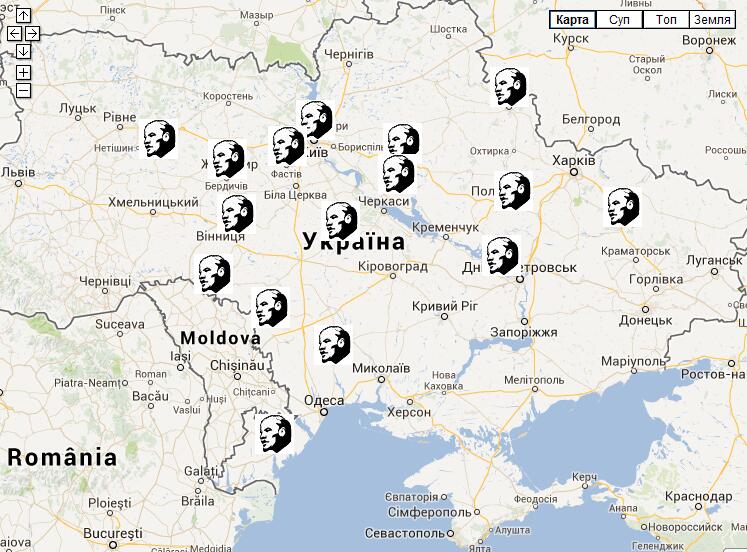
Here's another update, an article from the BBC entitled Ukraine Commits Statuecide.
-
With Lenin's Changes Removed, Tsarist Obelisk Unveiled Near Kremlin
- December 22, 2013 - 7:33 pm
- Lenin, Russia
- Comments Off on With Lenin's Changes Removed, Tsarist Obelisk Unveiled Near Kremlin
MOSCOW, November 4, 2013 (RIA Novosti) The head of the Russian Orthodox Church and senior Russian officials attended the opening of a resurrected Tsarist-era obelisk outside the Kremlin walls Monday.
The monument was originally unveiled 99 years ago to commemorate the 300th anniversary of Russia's Romanov dynasty, but its Tsarist iconography was removed in 1918 on the orders of Vladimir Lenin and the names of Romanov emperors replaced by famous international revolutionaries.
In the renovated version unveiled Monday, criticized by some architectural preservation groups for poor quality work, the communist-era changes have been reversed.
"Today, an unjust historical action has been set right," said Patriarch Kirill of Moscow and All Russia during the opening ceremony, which was also attended by Culture Minister Vladimir Medinsky and Sergei Ivanov, the head of the Presidential Administration, Russian media reported.
"It was done so that we could be conscious of ourselves as a people united temporally and geographically. We cannot live in separation from our history," Patriarch Kirill said.
The monument was taken down and sent for restoration in July after officials said that its condition had deteriorated and that it was in danger of collapsing.
Architectural preservation group Arkhnadzor criticized the restoration work in a statement last week, noting that the restored monument was adorned with "false imitations of Romanov decoration."
The opening Monday coincided with Russia's National Unity Day, a holiday introduced by the Kremlin in 2005 to replace the communist holiday of November 7 celebrating the 1917 Bolshevik Revolution.
-
Eternal Leaders
From the Washington Post, embalmed leaders of the world. The story is below; go to http://www.washingtonpost.com/blogs/worldviews/wp/2013/03/08/a-photographic-guide-of-the-worlds-embalmed-leaders/?wprss=rss_world for a fascinating set of photos/videos as well.
A photographic guide to the world’s embalmed leaders
By Caitlin Dewey , Updated: March 8, 2013
When Hugo Chavez’s embalmed body is laid in a glass casket sometime next week, he will join at least eight other world leaders whose remains are on display for all eternity … or at least for as long as their keepers can preserve them.
Vice President Nicolas Maduro announced Thursday that Chavez’s body would be on permanent display at the Museum of the Revolution so that “his people will always have them.” While that idea may sound grotesque, it’s also not particularly novel.
The Russians, arguably the ones who perfected the practice, have put both Vladimir Lenin and Joseph Stalin on long-term display. Lenin’s body has been embalmed in a large tomb near the Kremlin since shortly after his death in 1924, preserved by a steady 61 degree temperature and a strict regimen of mild bleachings and soaks in glycerol and potassium acetate.
According to Time, Stalin’s embalmed body also laid near Lenin’s for about 10 years, but was hastily reburied under cover of darkness when the government tried to squash his cult of personality in the early ’60s.
The Russians seem to have inspired the North Koreans to similar displays. In 1994, a Russian team helped preserve the body of Kim Il-sung, North Korea’s founding president, the New York Times reports.
When Kim Jong Il died in late 2011, Russian scientists again went to Pyongyang to assist in the embalming; the late leader lies in a glass sarcophagus with filtered lights to keep his face looking rosy.
But Kim Jong Il and his father were by no means the first Asian leaders to get the Chavez treatment. The Vietnamese revolutionary Ho Chi Minh, who died in 1969, is displayed in a mausoleum in Hanoi modeled after Lenin’s. Since “Uncle Ho” died in the midst of the Vietnam War, his embalmers had to work in a cave in the North Vietnamese jungle, the New York Times reports.
One of the scientists who worked on him told the Times: “Not every expert is allowed to restore such treasured historical objects, like a Raphael or a Rembrandt. Those who do it, we tremble. I feel a great responsibility in my hands.” This video shows the changing of the guard outside Ho Chi Minh’s tomb.
Socialist leader Mao Zedong has lain in state in a mausoleum on Beijing’s Tiananmen Square since May 1977. According to Time, Soviet-Chinese tensions forced Mao’s embalmers to ask the Vietnamese, not the Russians, for advice — a plan that misfired slightly when the Vietnamese could not explain how to build an air-tight coffin.
The exiled Filipino dictator Ferdinand Marcos, who died in 1989, has lain embalmed in a public mausoleum in the northwest Philippines since the government allowed his body back into the country in 1993. His widow, Imelda Marcos, has battled the government for permission to bury him in the country’s presidential cemetery, the New York Times reports. She posted for photos kissing the crypt in 2010.
Chavez will be only the second Latin American leader to be preserved for all eternity. Embalmers emptied water from the cells of Eva Peron, the wife of Argentinian president Juan Peron, and replaced them with wax — an unusual technique that basically “turned her into a candle,” Egyptologist Bob Brier told the Post’s Monica Hesse in 2012. She’s now also missing a finger — when the junta overthrew Peron’s husband and took over their house, they cut one off to see if the body was fake.
Chavez’s body will, presumably, get better protection than that. AFP reports that Marcos’s embalmer has already offered up his services and is urging the Venezuelans to start the process before it gets “more difficult.”
“I will process anyone, anywhere,” he said, helpfully.

